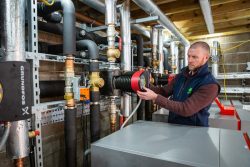 THE National Trust’s Kingston Lacy house near Wimborne will save 30,000 litres of oil a year following a switch to a ground source heat pump. The project is part of the Trust’s renewable energy work to reach net zero by 2030.
THE National Trust’s Kingston Lacy house near Wimborne will save 30,000 litres of oil a year following a switch to a ground source heat pump. The project is part of the Trust’s renewable energy work to reach net zero by 2030.
It is one of the Trust’s biggest heat pump projects to date, and the first high temperature ground source system the charity has installed. The old oil tank has been replaced by almost 6,000m of underground pipes, which transport natural ambient heat in the ground to four high temperature heat pumps, that in turn warm the mansion house and courtyard buildings. The complex installation of pipework involved drilling 32 vertical boreholes in an overflow carpark, with each hole measuring a staggering 180m in depth[1].
 Specialists spent two years conducting extensive archaeological and ecological surveys to ensure the protection of the historic parkland. As well as saving approximately 57 tonnes of carbon a year, the new heating system will remove the danger of oil spills from the previous ‘high risk’ boilers and storage tank.
Specialists spent two years conducting extensive archaeological and ecological surveys to ensure the protection of the historic parkland. As well as saving approximately 57 tonnes of carbon a year, the new heating system will remove the danger of oil spills from the previous ‘high risk’ boilers and storage tank.
Built to resemble a Venetian palace, Kingston Lacy was created by the Bankes family as one of the most opulent country houses in the south of England, with one of the UK’s finest collections of paintings, including works by Velazquez, Van Dyck and Titian.
 The heat pump will improve conservation of the building and its collection by stabilising the temperature and humidity levels.
The heat pump will improve conservation of the building and its collection by stabilising the temperature and humidity levels.
Owen Griffith, them Trust’s renewable heating project manager, says: “Not only will the heat pump reduce the property’s dependency on fossil fuels, but it’ll create a safer environment and improve conditions for the amazing collection items here. There are so many advantages. Magnificent buildings like these have been around for centuries, but their heating systems have evolved – from open fires to coal boilers and then oil boilers, with many energy innovations along the way. This is simply the next step in Kingston Lacy’s history and preservation.”
The project at Kingston Lacy has been made possible by a funding contribution from Low Carbon Dorset as part of the European Regional Development Fund.
Photographs by James Dobson